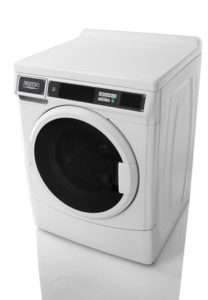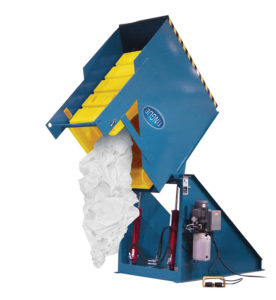MANCHESTER, NH—The Internet of Things (IoT) is becoming a reality in hospitality in many ways—beacons that locate guests on property so the hotel can push offers and deals to the guests’ phones; the ability to control temperature, shades, lighting and the television in guestrooms; and solutions that detect when room trays are left in the hall to avoid unsightly corridors—are just a few of the ways hospitality is approaching the connected ecosystem. But have you thought about the benefits of incorporating laundry?
Much like IoT solutions that monitor room temperature, the return on investment connected to linking the laundry room and its devices to the cloud can be tangibly seen, and this can result in efficiencies in a variety of ways. IoT devices make it possible to monitor real-time water, energy, cycle time and detergent usage, and track those via benchmarks. Also, these reports can be broken down by individual machine; locations, provided the owner or operator has more than one property; or overall, for the entire enterprise. IoT solutions also add a measure of flexibility for management, as the reports can be accessed remotely from any device that’s connected to the internet.
Jonathan Benjamin, global president, laundry, Xeros Inc., which offers IoT laundry solutions to its hotel clients, said, “For us, IoT and connected technologies have been a foundational element of our commercialization plan and strategy. Each of our machines is connected in such a way that not only can we keep track of what’s happening with them, but validate and substantiate what the machine is able to yield to the customer itself.” Benjamin noted this also makes other programs more efficient, such as the company’s Xtend program, a linen management solution for hotels designed to extend the life of linens and lower replacement costs, as compared to traditional aqueous-based washing. “We leverage not only the fact that our machines are connected, but the data that we’ve been able to pull off of them,” he said.
The benefits for the hotel are many, according to Benjamin. “‘Did I get what I’m paying for?’ That’s a simple one,” he said, noting that the data provided gives hoteliers proof of the value. “If we want to talk more broadly, the fact of the matter is laundry is an area of significant expense for hotels. We can help them understand where they’re spending their money. Through the use of information, how they can lower their costs—whether it’s through labor costs, utility costs or even chemical costs, and how that ultimately influences and, more importantly, reverberates throughout the entire hotel in terms of the costs they might incur outside the laundry room, such as on the floor, housekeeping and the like. It really can give them a good view of where they’re spending their money and saving their money, and where there’s opportunity for improvement.”
Noting this technology would be useful for “any hotel looking to save money, reduce its utility impact and improve sustainability scores,” Benjamin said hospitality is “still in the fundamental stages… There’s plenty of information at our fingertips: It’s how you use it and make it actionable. And, how can you actually take what’s there and turn it into real savings?”
And this will only increase as systems and solutions become linked together. “Certainly, as those back-of-house systems become more integrated with other systems that exist in a hotel, I do see an opportunity to end-to-end manage and improve overall operational efficiencies and bring them to the hotel,” he said.
He also noted that as sustainability becomes more important to guests, the ability to demonstrate that the hotel is environmentally friendly gives properties a marketing tool to appeal to guests and capture revenue. “We are in a world that’s changing. The ability to harness data and understand not only what it tells you today of how you can save money, but how it can really integrate into your message for your brand, is where I think there will be future opportunity for justification of the systems we all talk about today,” said Benjamin.
And, he noted, this future won’t just connect in-house solutions as the company recently implemented the ability to connect off-property as well. “It leverages not only the connections we have in the hotel but connections outside of the hotel around changes in utility rates and changes in compliance matters,” said Benjamin. “Drive for technologies like this and how that connects to our consumers is something we’re looking for and is a vision of where we want to go as a business—ultimately, B2B versus B2C becomes much more of a bridged and connected world that doesn’t exist today.” HB
NEW PRODUCTS
Laundry product supplier Tingue has introduced a hydraulic laundry cart dumper aimed at upgrading worker safety and speed productivity in the incoming soil-sort area. With the push of a button, the cart dumper automatically lifts loaded laundry carts and turns them upside down for emptying onto a sorting table or conveyor, then returns the cart to floor level for removal. According to the company, this eliminates pain points associated with manual handling of laundry, including heavy lifting and time-intensive procedures. Featuring a steel structure, the cart dumper is designed to lift and dump up to 1,500 lbs. with minimal maintenance, according to the company. The cart dumper fits the industry-standard Poly-Trux(R)72P-style bulk-laundry carts and a variety of other carts with an overall height up to 67 in. and a width up to 29 in., and is available in custom sizes. The automated cart dumper comes with a 2 HP motor as standard with a choice of left- or right-side controls and arrives fully assembled and ready to plug in and operate.
 The new Maytag Commercial Laundry Single-Load, Front-Load Washer features advanced spin technology—which, combined with its six-point suspension, accelerometer, progressive spin logic and pump routine, is designed to deliver more accurate cycle times and better unbalanced performance for a variety of load types, according to the company. It also has a DuraCore Drive System, a watertight, flexible, triple-lip seal with garter springs designed to keep moisture away from the shaft, protecting its premium bearings, while the durable shaft sleeve is designed to eliminate shaft wear. Intelligent controls allow customized setup and Maytag Connect 360° technology offers real-time machine diagnostics. The machine, which uses approximately 10.71 gallons of water per cycle, has an Energy Star designation.
The new Maytag Commercial Laundry Single-Load, Front-Load Washer features advanced spin technology—which, combined with its six-point suspension, accelerometer, progressive spin logic and pump routine, is designed to deliver more accurate cycle times and better unbalanced performance for a variety of load types, according to the company. It also has a DuraCore Drive System, a watertight, flexible, triple-lip seal with garter springs designed to keep moisture away from the shaft, protecting its premium bearings, while the durable shaft sleeve is designed to eliminate shaft wear. Intelligent controls allow customized setup and Maytag Connect 360° technology offers real-time machine diagnostics. The machine, which uses approximately 10.71 gallons of water per cycle, has an Energy Star designation.



